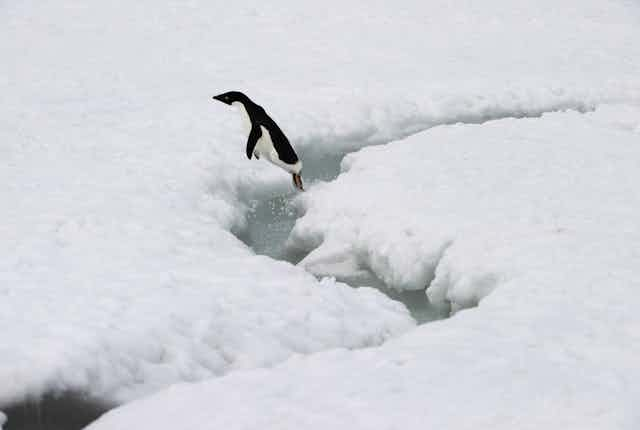The general thrust of the IPCC’s Fifth Assessment Report - released on Friday – can be summarised as: “there is now more evidence that climate change is occurring”. Antarctica and the Southern Ocean are significant drivers of the global climate system, and the report has some detailed findings on what is happening in this region.
As the complete reports of the IPCC are released the questions about how much we know about the Antarctic - or more importantly, how much we don’t know - will become apparent. Our understanding of past climate will be enhanced by further studies, including of ice cores. This is vital, in order to understand what our future climate may be.
Even though the past two decades of research have revealed great changes to the deep ocean in the Antarctic, there is much that we do not know, especially about what is happening under the ice. And one of the greatest unknown in estimates of future sea level rise is the dynamic response of the Antarctic ice sheet, especially that part which is grounded below sea level.
Ocean acidification may have significant ramifications for Southern Ocean life - and the Southern Ocean has the largest underexploited fishery in the world, the krill fishery.
The Antarctic ice sheet
“There is stronger evidence that the ice sheets and glaciers worldwide are losing mass” the Fifth Assesment report says. In the precise language of the IPCC, there is very high confidence that the Arctic, and high confidence that the Antarctic ice sheets have lost mass over the last two decades.
In Antarctica the average rate of mass loss has likely increased substantially over the last two decades. There is very high confidence that these losses are mainly from the Antarctic Peninsula and Amundsen Sea region of West Antarctica.
Antarctic ice cores
Ice cores provide a detailed record of past climate through the tiny air bubbles that are trapped in the ice. Ice cores have shown that the present-day concentrations of greenhouse gasses (carbon dioxide, nitrous oxide and methane) “substantially exceed” the 800,000 year record from ice cores. There is very high confidence that the rate of increase of these greenhouse gasses is unprecedented in the last 22,000 years.
Antarctic sea ice
Sea ice is formed by the freezing of ocean water, unlike the ice sheets which are made up of accumulated snow.
While the Arctic sea ice has declined substantially, “Antarctic sea ice cover shows a small increase”. Overall, Antarctic sea ice has very likely increased at around 1.2 to 1.8% per decade between 1979 and 2012. This equates to around 285,000 square kilometres of sea ice. The comparable loss of sea ice in the Arctic was around 1.8 million square kilometres of sea ice maximum annual extent during this period.
There are large regional differences in sea ice cover in the Antarctic, with some (such as the Ross Sea region) increasing in extent, and some (such as the west Antarctic Peninsula) decreasing significantly.
Antarctica’s contribution to sea level rise
Global mean sea level has risen by 0.19m from 1901−2010. IPCC AR5 says that it is very likely that the rate of sea level rise increased to 3.2mm per year 1993 and 2010.
Recent, more comprehensive paleoclimate reconstructions have allowed for better estimates of past temperature and sea level rise. During the last interglacial period (129,000 to 116,000 years ago, when the earth was not more than 2 degrees warmer than pre-industrial earth), sea level was at least 5m higher than present (the IPCC says with very high confidence).
During that period, while the Greenland ice sheet very likely contributed between 1.4 and 4.3m to sea level rise, the Antarctic ice sheet must also have contributed to sea level rise.
There is medium confidence that snowfall will increase in the Antarctic, adding to the mass of the Antarctic ice sheet and counteracting some mass loss, but it is also likely that the outflow of ice from glaciers in Greenland and Antarctica will contribute to mean sea level rise.
Changes in the Southern Ocean
IPCC AR5 says that it is virtually certain that, globally, the upper ocean (0−700m) has warmed from 1971 to 2010, and likely between the 1870s and 1971. The deep ocean, below 3000m depth, has likely warmed since the 1990s. This warming of the deep ocean is greatest in the Southern Ocean and the North Atlantic where these deep ocean currents are generated.
Ocean acidification
The uptake of anthropogenic carbon dioxide by the global oceans has led to them becoming more acidic (very likely). The pH of ocean water has decreased by 0.1 since the beginning of the industrial era. pH is a logarithmic scale so that this represents an increase in the concentration of hydrogen ions in the water of 26%. The cold waters of the polar regions disproportionately absorb carbon dioxide - because they are very cold. It is expected that many of the consequences of ocean acidification will be observed in the Arctic, and the Southern Ocean, before other parts of the globe.
Read more IPCC analysis here.

